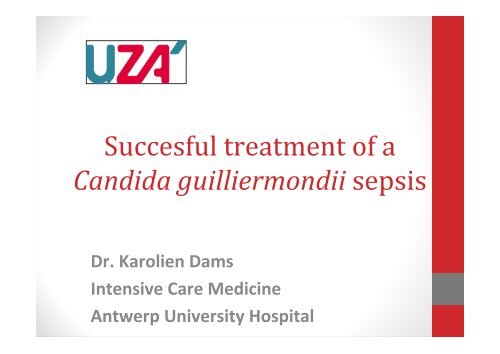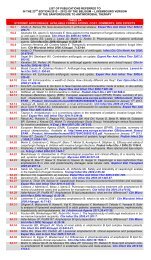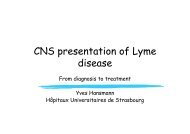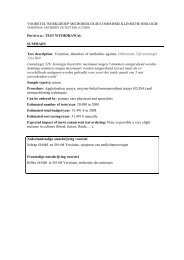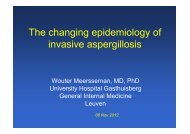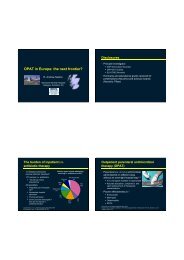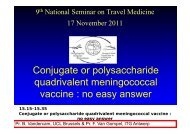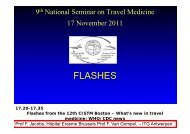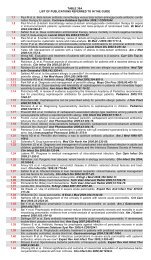Question 3: Candida guilliermondii is
Question 3: Candida guilliermondii is
Question 3: Candida guilliermondii is
- No tags were found...
Create successful ePaper yourself
Turn your PDF publications into a flip-book with our unique Google optimized e-Paper software.
<strong>Candida</strong> <strong>guilliermondii</strong>Dr. Karolien DamsIntensive Care MedicineAntwerp University Hospital
• No focus found• Central venous catheter changed• Transesophageal echocardiography• Fundoscopy• Cultures of pancreatic necros<strong>is</strong> > fine needleaspiration and necrosectomy• Identification: C. <strong>guilliermondii</strong>• Fungigram: intermediate susceptibility for FLU(MIC 32 mg/l) switch to voriconazole (VRCZ)
• 1 st Positive blood cultures: second strain of C.<strong>guilliermondii</strong>, res<strong>is</strong>tant to FLU (MIC 64 mg/l) VRCZ + liposomal amphotericin B (L-AmB)• Dose adjustment of VRCZ according to weeklytherapeutic drug monitoring (TDM)• Stop L-AmB as soon as TDM VRCZ within range
<strong>Candida</strong> <strong>guilliermondii</strong>• Rare• Temporal change in species d<strong>is</strong>tribution over thelast 20 years 1• Innate virulence compared to C. albicans• Serious pathology: mostly fungemias and deepseatedinfections in cancer patients• Greater propensity to express multidrugres<strong>is</strong>tance than other organ<strong>is</strong>ms of the genus<strong>Candida</strong>1. Arendrup MC., Curr Opin Crit Care 2010; 445-452
• Limited observations 1• Widely d<strong>is</strong>tributed• in nature• on human skin• Mostly recovered in cancer, hematology anddermatology services• Pseudo-outbreak in pediatric patients in Brasil 21. Arendrup MC., Curr Opin Crit Care 2010; 445-4522. Servolo Medeiros et al., JCM 2007; 942-947
<strong>Question</strong> 1The following are knownr<strong>is</strong>k factors for <strong>Candida</strong> <strong>guilliermondii</strong>00infection:1 - Hematological malignancy2 - Longterm antifungal treatment3 - Mechanical ventilation4 - Sedation
<strong>Question</strong> 1The following are knownr<strong>is</strong>k factors for <strong>Candida</strong> <strong>guilliermondii</strong>infection:1 - Hematological malignancy0%2 - Longterm antifungal treatment0%3 - Mechanical ventilation4 - Sedation0%0%
<strong>Question</strong> 2 The incidence of candidemia hasincreased over the last decades. Which of thefollowing <strong>is</strong> true?001 - C. albicans <strong>is</strong> still the major pathogen2 - Mainly C. glabrata infection incidence has increased3 - Non-albicans <strong>Candida</strong> spp. occur more frequently in cancerpatients, but are less common among ICU and surgical patients,children or HIV-positive patients4 - All of the above are true
<strong>Question</strong> 2 The incidence of candidemia hasincreased over the last decades. Which of thefollowing <strong>is</strong> true?1 - C. albicans <strong>is</strong> still the majorpathogen2 - Mainly C. glabrata infectionincidence has increased3 - Non-albicans <strong>Candida</strong> spp. morefrequently in cancer patients, but
Change in <strong>Candida</strong> d<strong>is</strong>tribution inICU, Antwerp University Hospital
• Yeast-like organ<strong>is</strong>m• Easily grows on Sabouraud dextrose agar, butnot on the Sabouraud broth surface• Colonies are typically flat, mo<strong>is</strong>t and smooth,with cream or yellow pigmentation• Extremely difficult to differentiatephenotypically from C. famata correctcharacter<strong>is</strong>ation by genome-based assays
<strong>Question</strong> 3: <strong>Candida</strong> <strong>guilliermondii</strong> <strong>is</strong>001. As susceptible to FLU as to VRCZ2. More susceptible to FLU as to VRCZ3. Less susceptible to FLU as to VRCZ4. Not susceptible to FLU nor to VRCZ
<strong>Question</strong> 3: <strong>Candida</strong> <strong>guilliermondii</strong> <strong>is</strong>As susceptible to FLU as to VRCZ0%More susceptible to FLU as to VRCZ0%Less susceptible to FLU as to VRCZ0%Not susceptible to FLU nor to VRCZ0%
• AZOLES• C. <strong>guilliermondii</strong>: susceptibility to FLU (75.2%)compared to C. albicans (97.8%) 1• No widespread azole res<strong>is</strong>tance, most strainsshow panazole susceptibility• Empirical treatment with FLU• VRCZ more active than FLU (91%)= similar to C. glabrata 1• Res<strong>is</strong>tance > efflux pumps, alteration of the targetenzyme of azoles (14 α-demethylase) 21.Savini et al., Mycoses 2010; 434-4412.Arendrup MC, Curr Opin Crit Care 2010; 445-452
• ECHINOCANDINS• The least echinocandin-susceptible yeast 1• Inherent and acquired echinocandin res<strong>is</strong>tance:sporadically observed• MICs for echinocandins 2- to 100-fold higher forC. <strong>guilliermondii</strong>• Imperfect correlation between MICs and clinicaloutcome 2• Treatment success rate with an echinocandin 89%with an overall mortality of 19%. 1, 31. Colombo et al., AAC 2010; 1864-18712. Savini et al., Mycoses 2010; 434-4413. Chen et al., CMI 2009; 662-669
• POLYENES• Most strains show susceptibility to L-AmB• Intrinsically less susceptible to polyenes• FLUCYTOSINE• Limited studies• Most <strong>is</strong>olates susceptible 11. Colombo et al., AAC 2010; 1864-1871
• Rates of C. non-albicans fungemias haveincreased over the past years• Importance of correct identification at specieslevel• Multidrug res<strong>is</strong>tance in C. <strong>guilliermondii</strong> <strong>is</strong> ofconcern• Start empirical treatment in C. non-albicansfungemia with an echinocandin, followed bytargeted treatment guided by susceptibilitytesting results


